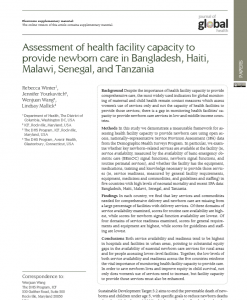
Background
Despite the importance of health facility capacity to provide comprehensive care, the most widely used indicators for global monitoring of maternal and child health remain contact measures which assess women’s use of services only and not the capacity of health facilities to provide those services; there is a gap in monitoring health facilities’ capacity to provide newborn care services in low and middle income countries.
Methods
In this study we demonstrate a measurable framework for assessing health facility capacity to provide newborn care using open access, nationally–representative Service Provision Assessment (SPA) data from the Demographic Health Surveys Program. In particular, we examine whether key newborn–related services are available at the facility (ie, service availability, measured by the availability of basic emergency obstetric care (BEmOC) signal functions, newborn signal functions, and routine perinatal services), and whether the facility has the equipment, medications, training and knowledge necessary to provide those services (ie, service readiness, measured by general facility requirements, equipment, medicines and commodities, and guidelines and staffing) in five countries with high levels of neonatal mortality and recent SPA data: Bangladesh, Haiti, Malawi, Senegal, and Tanzania.
Findings
In each country, we find that key services and commodities needed for comprehensive delivery and newborn care are missing from a large percentage of facilities with delivery services. Of three domains of service availability examined, scores for routine care availability are highest, while scores for newborn signal function availability are lowest. Of four domains of service readiness examined, scores for general requirements and equipment are highest, while scores for guidelines and staffing are lowest.
Conclusions
Both service availability and readiness tend to be highest in hospitals and facilities in urban areas, pointing to substantial equity gaps in the availability of essential newborn care services for rural areas and for people accessing lower–level facilities. Together, the low levels of both service availability and readiness across the five countries reinforce the vital importance of monitoring health facility capacity to provide care. In order to save newborn lives and improve equity in child survival, not only does women’s use of services need to increase, but facility capacity to provide those services must also be enhanced.
This article belongs to a Journal of Global Health Supplement titled “Measuring coverage of essential maternal and newborn care interventions: An unfinished agenda.”